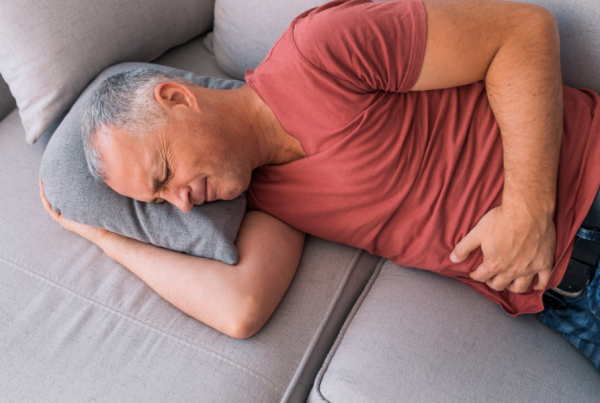Rectal Pain
Move Better. Live Fuller. Your Wellness Journey Starts Here.
Schedule a FREE Discovery Call!
What Is Rectal Pain?
Rectal pain is pain or discomfort associated with the rectum, which is the area between the anus and the lower portion of the digestive tract. Rectal pain is a common complaint, although it can have many different causes.
Pain in the rectum can be described as anything from a mild discomfort to sharp, sudden, or stabbing pain that comes and goes. If the area becomes swollen, you may feel pressure in the area.
Other symptoms related to pain in the rectum can vary depending on the cause, but commonly include:

- Difficult or painful bowel movements
- Pain after bowel movements
- Bleeding
- Pain or discomfort when sitting
- Painful intercourse
- Itchiness
- Pain during menstruation
- Irritation
Rectal pain can be referred to by other names, some that are more specific to the cause or type of pain. Many terms are used interchangeably to describe rectal pain, or can be used together to further describe a condition or set of symptoms involving rectal pain. Some examples include:
- Proctalgia: The general term for rectal pain.
- Anodynia: A less common general term for rectal pain.
- Levator ani syndrome: Pain caused by problems with the levator ani muscle of the pelvic floor.
- Proctalgia fugax: A variant of levator ani syndrome that causes a sudden, sharp pain in the anus. Can happen due to unknown causes.
- Anal pain: Pain specific to the anus, which is the opening where stool leaves the digestive tract. This term is more specific, but is often used interchangeably with “rectal pain.”
- Anorectal pain: Pain in both the anus and rectum.
- Pudendal neuralgia: Pain caused by problems with the pudendal nerve, an important nerve that controls function and sensation of the genitals and anus. This nerve can cause pain in the rectum when it becomes compressed or irritated.
- Coccydynia: Pain near the tailbone (coccyx) which may radiate to other areas, such as the rectum.
- Pelvic floor dysfunction: Tightness, weakness, inflexibility, or a lack of coordination of the pelvic floor muscles can cause or exacerbate many of the conditions related to rectal pain—which is why pelvic floor physical therapy is a great form of treatment for many situations!
What Causes Rectal Pain?
Rectal pain can be caused by a wide variety of conditions affecting many different bodily systems—gastrointestinal, musculoskeletal, neurological, and reproductive. Rectal pain can occur to any person, regardless of their genitals. However, certain conditions affecting different reproductive organs can cause or lead to rectal pain and discomfort. Some examples include:
For those with a vagina: Endometriosis and pelvic inflammatory disease can cause referred pain to the rectum.
For those with a penis: Chronic prostatitis and pelvic pain syndrome can also lead to tension, inflammation, or pain in the rectum.
Additionally, rectal pain can occur for those who undergo genital reconstruction surgery in the pelvic region. This is because the procedure’s proximity to the rectum and anus may cause pain or discomfort via referred pain or nerve damage.
Outside of causes specific to reproductive systems, conditions can include:
- Pelvic floor dysfunction: Pelvic floor dysfunction is a major condition to consider, as it can arise both as a cause or a result of these other conditions (as mentioned earlier). Pelvic floor dysfunction can present itself in a variety of symptoms, such as constipation, fecal incontinence, painful bowel movements, and much more!
- Pelvic floor tension myalgia: Extreme tension in the pelvic floor muscles that is so excessive that it leads to severe pelvic pain, discomfort, and muscle spasms.
- Hemorrhoids: These are blood vessels in the anus or rectum that have become swollen and painful. They can cause itching, bleeding, and painful bowel movements. Hemorrhoids are a common cause of rectal pain.
- Anal fissures: Tears in the anal lining, which causes pain during bowel movements—this pain may radiate to the rectum as well.
- Inflammatory bowel diseases (IBD): Chronic diseases of the gastrointestinal tract, such as Crohn’s and ulcerative colitis, often have symptoms of rectal pain.
- Prolapse: Prolapse, specifically rectal prolapse, can cause rectal discomfort.
- Nerve irritation or compression: When nerves of the pelvic floor such as the pudendal nerve become irritated or compressed, they can lead to rectal pain and discomfort.
- Infection: Infection within the anal glands can cause the formation of abscesses or fistulas. Both of these growths can cause rectal pain and discomfort.
- Levator ani syndrome: As mentioned earlier, this condition of the pelvic floor muscles (specifically the levator ani muscle) can create rectal and vaginal pain due to muscle spasms.
- Proctitis: Inflammation of the rectum that can cause rectal pain, bleeding, diarrhea, and other symptoms. This condition can be caused by IBD, infection, or as a side effect of radiation therapy.
- Cancer: Some types of cancer such as rectal cancer can cause pain and other symptoms in the rectum and other areas.
Physical Therapy for Rectal Pain
Regardless of the cause of your rectal pain, pelvic floor physical therapy can be an effective form of treatment. Your physical therapist will work to reduce pain, improve function of the pelvic floor and other related muscles, release tension in the pelvis, and educate you on ways to manage your condition. Treatment may vary depending on the cause of your rectal pain, but can involve any of the following:
Improving Pelvic Floor Health
As mentioned earlier, pelvic floor dysfunction can be involved with rectal pain or conditions that cause rectal pain. This is because the pelvic floor plays a main role in bowel movements—the health of your pelvic floor directly affects your ability to have smooth bowel movements.
When the pelvic floor is tight, weak, or unable to coordinate properly, bowel movements can become difficult and painful. Chronic conditions can be worsened by pelvic floor dysfunction, and tension in the pelvis can create a number of other problems. Therefore, the pelvic floor cannot be ignored when treating rectal pain!
To optimize the health of your pelvic floor, your pelvic floor therapist will educate you on pelvic floor anatomy, increase awareness of your pelvic floor muscles and what it feels like to contract or relax them, and create an exercise plan to strengthen those muscles. As part of your pelvic floor treatment, you can expect exercises to improve relaxation and flexibility of your muscles through stretching and breathing exercises. All of these tasks will allow you to coordinate your pelvic floor properly, and allow for the muscles to be healthy, flexible, and strong.
Neuromuscular Re-Education and Biofeedback
These treatments help the muscles of the pelvic floor regain normal function and responsiveness to nerve signals. Your physical therapist will utilize these treatments so you can regain control over your pelvic floor muscles and your ability to coordinate, relax, or contract those muscles as needed. This can relieve tension in those muscles and reduce pain.
Behavioral Modifications
An important aspect of treatment that Hive’s physical therapists practice is prevention! Your physical therapist will analyze your posture and habits to determine any possibilities that could be causing or contributing to your pain. This can include posture while sitting, standing, sitting on the toilet, or during different activities. Bathroom habits are also considered, as patients may have harmful bathroom habits contributing to their rectal pain, difficult bowel movements, constipation, and so on.
Additionally, your physical therapist may recommend lifestyle changes such as diet modifications or increasing fluid intake to encourage healthier bowel movements, especially for rectal pain directly relating to bowel movements, constipation, or chronic conditions.
Pain Management
Your pelvic floor therapist can help you manage rectal pain in a variety of ways! This is especially useful for those with chronic conditions who have to deal with tension returning during flare-ups. Some pain management methods can include dry needling, tissue scraping, heat or cold therapy, manual therapy, and more. They can use techniques such as myofascial release to relieve tension and reduce muscle spasms in a variety of areas—such as the hips, abdomen, lower back, or pelvis—to reduce your pain overall.
Education
The physical therapists at Hive are passionate about teaching their patients a multitude of important aspects relevant to their health goals or treatment. This can include optimizing things like body mechanics or modifying certain activities, and even understanding concepts like anatomy or pain neuroscience. When working with Hive, you can expect to have your questions answered and your concerns heard properly!
Lastly, you can expect to receive plenty of advice and education on managing your symptoms at home. This ties into the behavioral modifications mentioned previously, but involves learning how to do stretches or self-massage for relief outside of the clinic. Your physical therapist will prescribe you an exercise plan to support your long-term health goals.
As you can see, the pelvic floor physical therapists at Hive Therapy and Wellness take a holistic treatment approach in order to improve the quality of life of patients struggling with rectal pain. They will utilize a variety of treatments in a care plan that is curated to your unique needs, which may include any of the following:
- Neuromuscular re-education
- Manual therapy
- Exercise prescription
- Dry needling
- Cupping
- Tissue scraping
- Behavioral modifications
- Therapeutic activities
- Electrical muscle stimulation
- Spinal manipulation
- Therapeutic modalities
- Biofeedback
Rectal pain is pain or discomfort associated with the rectum, which is the area between the anus and the lower portion of the digestive tract. Rectal pain is a common complaint, although it can have many different causes.
Pain in the rectum can be described as anything from a mild discomfort to sharp, sudden, or stabbing pain that comes and goes. If the area becomes swollen, you may feel pressure in the area.
Other symptoms related to pain in the rectum can vary depending on the cause, but commonly include:
- Difficult or painful bowel movements
- Pain after bowel movements
- Bleeding
- Pain or discomfort when sitting
- Painful intercourse
- Itchiness
- Pain during menstruation
- Irritation
Rectal pain can be referred to by other names, some that are more specific to the cause or type of pain.
Many terms are used interchangeably to describe rectal pain, or can be used together to further describe a condition or set of symptoms involving rectal pain. Some examples include:
- Proctalgia: The general term for rectal pain.
- Anodynia: A less common general term for rectal pain.
- Levator ani syndrome: Pain caused by problems with the levator ani muscle of the pelvic floor.
- Proctalgia fugax: A variant of levator ani syndrome that causes a sudden, sharp pain in the anus. Can happen due to unknown causes.
- Anal pain: Pain specific to the anus, which is the opening where stool leaves the digestive tract. This term is more specific, but is often used interchangeably with “rectal pain.”
- Anorectal pain: Pain in both the anus and rectum.
- Pudendal neuralgia: Pain caused by problems with the pudendal nerve, an important nerve that controls function and sensation of the genitals and anus. This nerve can cause pain in the rectum when it becomes compressed or irritated.
- Coccydynia: Pain near the tailbone (coccyx) which may radiate to other areas, such as the rectum.
- Pelvic floor dysfunction: Tightness, weakness, inflexibility, or a lack of coordination of the pelvic floor muscles can cause or exacerbate many of the conditions related to rectal pain—which is why pelvic floor physical therapy is a great form of treatment for many situations!
Rectal pain can be caused by a wide variety of conditions affecting many different bodily systems—gastrointestinal, musculoskeletal, neurological, and reproductive.
Rectal pain can occur to any person, regardless of their genitals. However, certain conditions affecting different reproductive organs can cause or lead to rectal pain and discomfort. Some examples include:
- For those with a vagina: Endometriosis and pelvic inflammatory disease can cause referred pain to the rectum.
- For those with a penis: Chronic prostatitis and pelvic pain syndrome can also lead to tension, inflammation, or pain in the rectum.
Additionally, rectal pain can occur for those who undergo genital reconstruction surgery in the pelvic region.
This is because the procedure’s proximity to the rectum and anus may cause pain or discomfort via referred pain or nerve damage.
Outside of causes specific to reproductive systems, conditions can include:
Pelvic floor dysfunction
Pelvic floor dysfunction is a major condition to consider, as it can arise both as a cause or a result of these other conditions (as mentioned earlier). Pelvic floor dysfunction can present itself in a variety of symptoms, such as constipation, fecal incontinence, painful bowel movements, and much more!
Extreme tension in the pelvic floor muscles that is so excessive that it leads to severe pelvic pain, discomfort, and muscle spasms.
These are blood vessels in the anus or rectum that have become swollen and painful. They can cause itching, bleeding, and painful bowel movements. Hemorrhoids are a common cause of rectal pain.
Tears in the anal lining, which causes pain during bowel movements—this pain may radiate to the rectum as well.
Inflammatory bowel diseases (IBD)
Chronic diseases of the gastrointestinal tract, such as Crohn’s and ulcerative colitis, often have symptoms of rectal pain.
Prolapse, specifically rectal prolapse, can cause rectal discomfort.
Nerve irritation or compression
When nerves of the pelvic floor such as the pudendal nerve become irritated or compressed, they can lead to rectal pain and discomfort.
Infection
Infection within the anal glands can cause the formation of abscesses or fistulas. Both of these growths can cause rectal pain and discomfort.
As mentioned earlier, this condition of the pelvic floor muscles (specifically the levator ani muscle) can create rectal and vaginal pain due to muscle spasms.
Proctitis
Inflammation of the rectum that can cause rectal pain, bleeding, diarrhea, and other symptoms. This condition can be caused by IBD, infection, or as a side effect of radiation therapy.
Cancer
Some types of cancer such as rectal cancer can cause pain and other symptoms in the rectum and other areas.
Regardless of the cause of your rectal pain, pelvic floor physical therapy can be an effective form of treatment.
Your physical therapist will work to reduce pain, improve function of the pelvic floor and other related muscles, release tension in the pelvis, and educate you on ways to manage your condition.
Treatment may vary depending on the cause of your rectal pain, but can involve any of the following:
Improving Pelvic Floor Health
As mentioned earlier, pelvic floor dysfunction can be involved with rectal pain or conditions that cause rectal pain.
This is because the pelvic floor plays a main role in bowel movements—the health of your pelvic floor directly affects your ability to have smooth bowel movements.
When the pelvic floor is tight, weak, or unable to coordinate properly, bowel movements can become difficult and painful.
Chronic conditions can be worsened by pelvic floor dysfunction, and tension in the pelvis can create a number of other problems. Therefore, the pelvic floor cannot be ignored when treating rectal pain!
To optimize the health of your pelvic floor, your pelvic floor therapist will educate you on pelvic floor anatomy, increase awareness of your pelvic floor muscles and what it feels like to contract or relax them, and create an exercise plan to strengthen those muscles.
As part of your pelvic floor treatment, you can expect exercises to improve relaxation and flexibility of your muscles through stretching and breathing exercises.
All of these tasks will allow you to coordinate your pelvic floor properly, and allow for the muscles to be healthy, flexible, and strong.
Neuromuscular Re-Education and Biofeedback
These treatments help the muscles of the pelvic floor regain normal function and responsiveness to nerve signals. Your physical therapist will utilize these treatments so you can regain control over your pelvic floor muscles and your ability to coordinate, relax, or contract those muscles as needed. This can relieve tension in those muscles and reduce pain.
Behavioral Modifications
An important aspect of treatment that Hive’s physical therapists practice is prevention! Your physical therapist will analyze your posture and habits to determine any possibilities that could be causing or contributing to your pain.
This can include posture while sitting, standing, sitting on the toilet, or during different activities. Bathroom habits are also considered, as patients may have harmful bathroom habits contributing to their rectal pain, difficult bowel movements, constipation, and so on.
Additionally, your physical therapist may recommend lifestyle changes such as diet modifications or increasing fluid intake to encourage healthier bowel movements, especially for rectal pain directly relating to bowel movements, constipation, or chronic conditions.
Pain Management
Your pelvic floor therapist can help you manage rectal pain in a variety of ways! This is especially useful for those with chronic conditions who have to deal with tension returning during flare-ups.
Some pain management methods can include dry needling, tissue scraping, heat or cold therapy, manual therapy, and more.
They can use techniques such as myofascial release to relieve tension and reduce muscle spasms in a variety of areas—such as the hips, abdomen, lower back, or pelvis—to reduce your pain overall.
Education
The physical therapists at Hive are passionate about teaching their patients a multitude of important aspects relevant to their health goals or treatment.
This can include optimizing things like body mechanics or modifying certain activities, and even understanding concepts like anatomy or pain neuroscience.
When working with Hive, you can expect to have your questions answered and your concerns heard properly!
Lastly, you can expect to receive plenty of advice and education on managing your symptoms at home.
This ties into the behavioral modifications mentioned previously, but involves learning how to do stretches or self-massage for relief outside of the clinic. Your physical therapist will prescribe you an exercise plan to support your long-term health goals.
As you can see, the pelvic floor physical therapists at Hive Therapy and Wellness take a holistic treatment approach in order to improve the quality of life of patients struggling with rectal pain.
They will utilize a variety of treatments in a care plan that is curated to your unique needs, which may include any of the following:
- Neuromuscular re-education
- Manual therapy
- Exercise prescription
- Dry needling
- Cupping
- Tissue scraping
- Behavioral modifications
- Therapeutic activities
- Electrical muscle stimulation
- Spinal manipulation
- Therapeutic modalities
- Biofeedback
You can learn more about these treatments on our Treatments Page.





